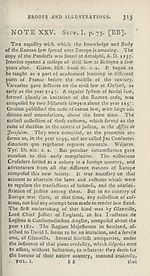Download files
Complete book:
Individual page:
Thumbnail gallery: Grid view | List view

JI4 PROOFS AND ILLUSTRATIONS.
that the Regiam Majeftatem is a production prior to the
treatife of Glanville ; and have brought themfelves to
believe, that a nation, in a fuperior (late of improve¬
ment, borrowed its laws and inlfitutions from one con-
fiderably lefs advanced in its political progrefs. The
internal evidence (were it my province to examine it)
by which this theory might be refuted, is, in my opinion,
decifive. The external circumftances which have feduced
Scottifh authors into this miftake, have been explained
with fo much precifion and candour by Sir David Dal-
rymple, in his examination of feme of the arguments for
the high antiquity of Regiam Majetlatem, Edin. 1760^
4to, that it is to be hoped the controverfy will not be
again revived. Pierre de Fontaines, who tells us, that
he was the firft who had attempted fuch a work in
France, compofed his Cmfcil, which contains an account
of the cuftoms of the country of Vermandois, in the
reign of St. Louis, which began A. D. Beaurramir,
the author of the Cojiurr.es de Beauwijis, lived about the
fame time. The EftablifTemens of St. Louis, containing
a large colledlion of the cuftoms which prevailed within
the royal domains, were publiftied by the authority of
that monarch. As foon as men became acquainted with
the advantages of having written cuftoms and laws, to
which they could have recourfe on every occafion, the
prafliceof colledling them became common. CharlesVII.
of France, by an ordonance, A. D. 1453, appointed
the cuftomary laws in every province of France to be
colledled and arranged. Velley and Villaret, Hiftoire,
tom. xvi. p. 113. His fucceftbr, Louis XL renewed the
injundtion. But this falutary undertaking hath never
been fully executed, and the jurifprudence of the French
nation remains more obfeure and uncertain than it
would have been if thefe prudent regulations of their
monarchs had taken effedb A mode of judicial deter¬
mination was eftabliftied in the middle ages, which af¬
fords the cleareft proof that judges, while they had no
other rule to dire£l their decrees but unwritten and
traditionary cuftoms, were often at a lofs how to find
out Uie fails and principles, according to which they
. - ■ were
that the Regiam Majeftatem is a production prior to the
treatife of Glanville ; and have brought themfelves to
believe, that a nation, in a fuperior (late of improve¬
ment, borrowed its laws and inlfitutions from one con-
fiderably lefs advanced in its political progrefs. The
internal evidence (were it my province to examine it)
by which this theory might be refuted, is, in my opinion,
decifive. The external circumftances which have feduced
Scottifh authors into this miftake, have been explained
with fo much precifion and candour by Sir David Dal-
rymple, in his examination of feme of the arguments for
the high antiquity of Regiam Majetlatem, Edin. 1760^
4to, that it is to be hoped the controverfy will not be
again revived. Pierre de Fontaines, who tells us, that
he was the firft who had attempted fuch a work in
France, compofed his Cmfcil, which contains an account
of the cuftoms of the country of Vermandois, in the
reign of St. Louis, which began A. D. Beaurramir,
the author of the Cojiurr.es de Beauwijis, lived about the
fame time. The EftablifTemens of St. Louis, containing
a large colledlion of the cuftoms which prevailed within
the royal domains, were publiftied by the authority of
that monarch. As foon as men became acquainted with
the advantages of having written cuftoms and laws, to
which they could have recourfe on every occafion, the
prafliceof colledling them became common. CharlesVII.
of France, by an ordonance, A. D. 1453, appointed
the cuftomary laws in every province of France to be
colledled and arranged. Velley and Villaret, Hiftoire,
tom. xvi. p. 113. His fucceftbr, Louis XL renewed the
injundtion. But this falutary undertaking hath never
been fully executed, and the jurifprudence of the French
nation remains more obfeure and uncertain than it
would have been if thefe prudent regulations of their
monarchs had taken effedb A mode of judicial deter¬
mination was eftabliftied in the middle ages, which af¬
fords the cleareft proof that judges, while they had no
other rule to dire£l their decrees but unwritten and
traditionary cuftoms, were often at a lofs how to find
out Uie fails and principles, according to which they
. - ■ were
Set display mode to:
![]() Universal Viewer |
Universal Viewer | ![]() Mirador |
Large image | Transcription
Mirador |
Large image | Transcription
| Antiquarian books of Scotland > Kings & rulers > History of the reign of the Emperor Charles V. > Volume 1 > (332) |
|---|
| Permanent URL | https://digital.nls.uk/109186315 |
|---|
| Description | By William Robertson. London : Cadell and Davies, 1798. |
|---|---|
| Shelfmark | ABS.1.76.13 |
| Additional NLS resources: | |
| Description | Thousands of printed books from the Antiquarian Books of Scotland collection which dates from 1641 to the 1980s. The collection consists of 14,800 books which were published in Scotland or have a Scottish connection, e.g. through the author, printer or owner. Subjects covered include sport, education, diseases, adventure, occupations, Jacobites, politics and religion. Among the 29 languages represented are English, Gaelic, Italian, French, Russian and Swedish. |
|---|

